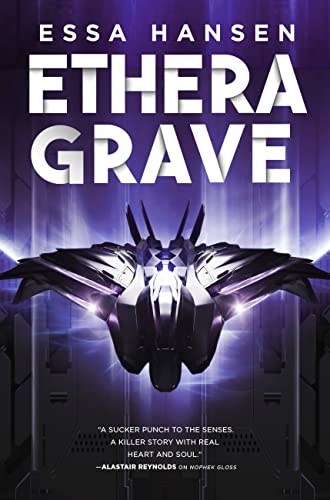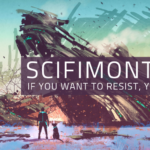Essa Hansen’s Ethera Grave may be the conclusion of her Graven trilogy (following Nophek Gloss and Azura Ghost), but it does far more than bring to an exciting and powerful conclusion a complex story. The novel expands its multiverse in dazzling ways and probes numerous questions of moral choice, diversity, transformation, time, the power of found family and the idea of death itself. Along the way, there are exciting combat scenes between humans and the supra-physical, near god-like entities known as the Graven and compelling personal stories. All of this is told in Hansen’s signature prose of rich and explosive imagery of light, color, sound and touch, a sensory abundance that is unique to her imagination and adds depth to every scene.
The Graven trilogy is a single story, so this final novel takes on its fullest meaning and impact if you come to it after reading the first two. Yet, with its comprehensive glossary, it can be read on its own. Since I read Nophek Gloss back in 2020 and Azura Ghost a year later, my memory was vague about the earlier books, and Ethera Grave provided everything I needed to bring back the essential points of the earlier books but without ever just dumping the background. Everything you need to know is tightly bound up with the action. And that action starts on the first page.
Abriss Cetre, ruler of Unity and inheritor of Graven genes that enable her to command loyalty, is intent on collapsing the multiverse, with its varying physics and sentient species, into a single universe. She believes she is doing good by eliminating conflict, poverty and environmental disaster. Yet the costs she refuses to see are clear from the outset. In the first chapter, we find Caiden, who possesses a similar genetic inheritance, trying to convince the beings of one planet about to be destroyed by impending collapse of its bubble in the multiverse that they must abandon their home. He does not want to compel their agreement with his will, through the power of his Graven influence, because he believes intensely in their right to make a free choice. They refuse because their spiritual beliefs are so strong that they think they can overcome the disaster on their own. But they are wrong, and, as Caiden leaves, their planet is engulfed in destruction.
From the opening scene, then, Hansen focuses on moral choice – that of Caiden to refuse the use of his special power to compel agreement, that of sentient species to choose their own future, that of Abriss to destroy diversity in the name of a higher good. At first the conflict about saving the multiverse is played out on a human level. Caiden works with Abriss’s brother Threi, who was once his enemy. They are joined by Leta, saved by Caiden in her childhood and later taken in by Abriss with whom she has since broken. All three prepare to battle Abriss and the forces she has bent to her power. Threi has catalogued the loss of vast numbers of species and irreplaceable environments as a result of Abriss’s campaign, yet even he is forced to admit that the world of Unity seems a great improvement and has to keep reminding himself and others that the cost of that seeming utopia is a brutal catastrophe. Every character has to weigh the costs of the battle they are engaged in. There are no simple answers.
After an initial battle with Abriss ends inconclusively, it becomes clear that the real fight is against the Graven, powerful beings of energy and luminiferous forces that can enter any physical form they choose. There are only a few Graven remaining since most of this race of beings was destroyed in eons past. They left behind architectural ruins of special indestructible materials, called lightseep obsidian, formed out of the basic energies of the universe. There are traces of their genetic inheritance remaining in Abriss and Caiden, and Abriss has developed a small number of entities sharing the power to receive shards of Graven being to function as super soldiers in her fight to transform the multiverse.
Ethera is the great Graven entity possessing Abriss while Caiden has bonded with Azura, whom he met first in the form of a sentient spaceship. Azura has since withdrawn into a remote part of the energic force known as the luminiferity, and Caiden must find her again to join in a powerful Graven entity that alone would be capable of taking on Ethera. So the conflict gradually shifts from one between the human characters to a plane where the god-like Graven exist before the story races to a final resolution.
The novel is enriched not only by the complexity of the choices facing the characters but also by an abundance of strange and endearing xenid species. There is C, the nophek – an omnivorous beast as big as a human who was tamed by Caiden as a pup but who can become a savage attacker when needed. There are the members of Caiden’s found family: Endirion Day, who started as human but added so many enhancements that they can change shape and gender to suit their mood; Ksine, an Andalvian, who is a scientist forever concocting new potions and cures; Panca, a saisn pilot, a tall, lean humanoid who can take in a vast amount of sensory data through a special organ in their brain. And there is a great variety more xenid species, each realized with precise physical detail and mannerisms. No matter how strange their physical form may be, they all express their feelings and concern for each other in moving ways.
Much of the emotional heart of the story revolves around Leta. Like many characters in Hansen’s fiction, Leta struggles to find a physical form that she feels comfortable in. She has separated from her original body in a form of death, only to find a more ethereal life in the energic realm of the luminiferity. For a time, she entered one of the Graven constructs as a loyal soldier under Abriss’s sway but was broken out of that to return to Caiden and Threi to help protect the multiverse. But, even though her platonic emotional bond with Caiden survives all her transformations, her struggle to find a body that suits her spirit continues throughout the story. Because of her detachment from the physical, she also perceives the inner struggles of other characters more clearly than they do and can remind them, especially Caiden, of the emotional barriers they must deal with. Her love for Isme, one of Abriss’s Graven constructs becomes especially moving as she rarely has a physical form that enables her to act on her feelings.
Essa Hansen’s prose is uniquely designed to capture the trans-physical realms, and she has developed a vocabulary all her own to capture the spiritual and immaterial realities. Her idea of the luminiferity as a dimension of boundless energy and consciousness existing outside of space-time enables her Graven characters to shape things on the fly and submerge whole worlds back into it. When Azura joins Caiden and the others on their travels, the prose captures the manifestation of her presence.
“Azura accompanied them as riots of color in the walls or bands of force aligning drifting sparkles, spreading out fifty meters of influence. The Graven city always roused in her presence, as if she made it recall a former state. Lightseep whispered eldritch vibrations across the air, strung with matter not yet fully manifest. Brilliance stormed awake in the floor. Dew-soft oxygen spilled from blooms on the ceiling and surged into Caiden’s lung as C sped into a lope.”
Ethera Grave, Kindle edition, Locations 1089-91
Like the entire Graven trilogy, Ethera Grave is a richly envisioned epic of multiversal conflict and of life unmade and remade in brilliant strokes of light and energy. For me, this third and final novel is the most powerful and moving in the series, as its heroes not only do battle but struggle to accept who they are and find homes amid found family and physical forms that match their spirit. This series is a great achievement.
My thanks to Orbit Books and NetGalley for an advance review copy on which I could base this review.





Leave a Reply